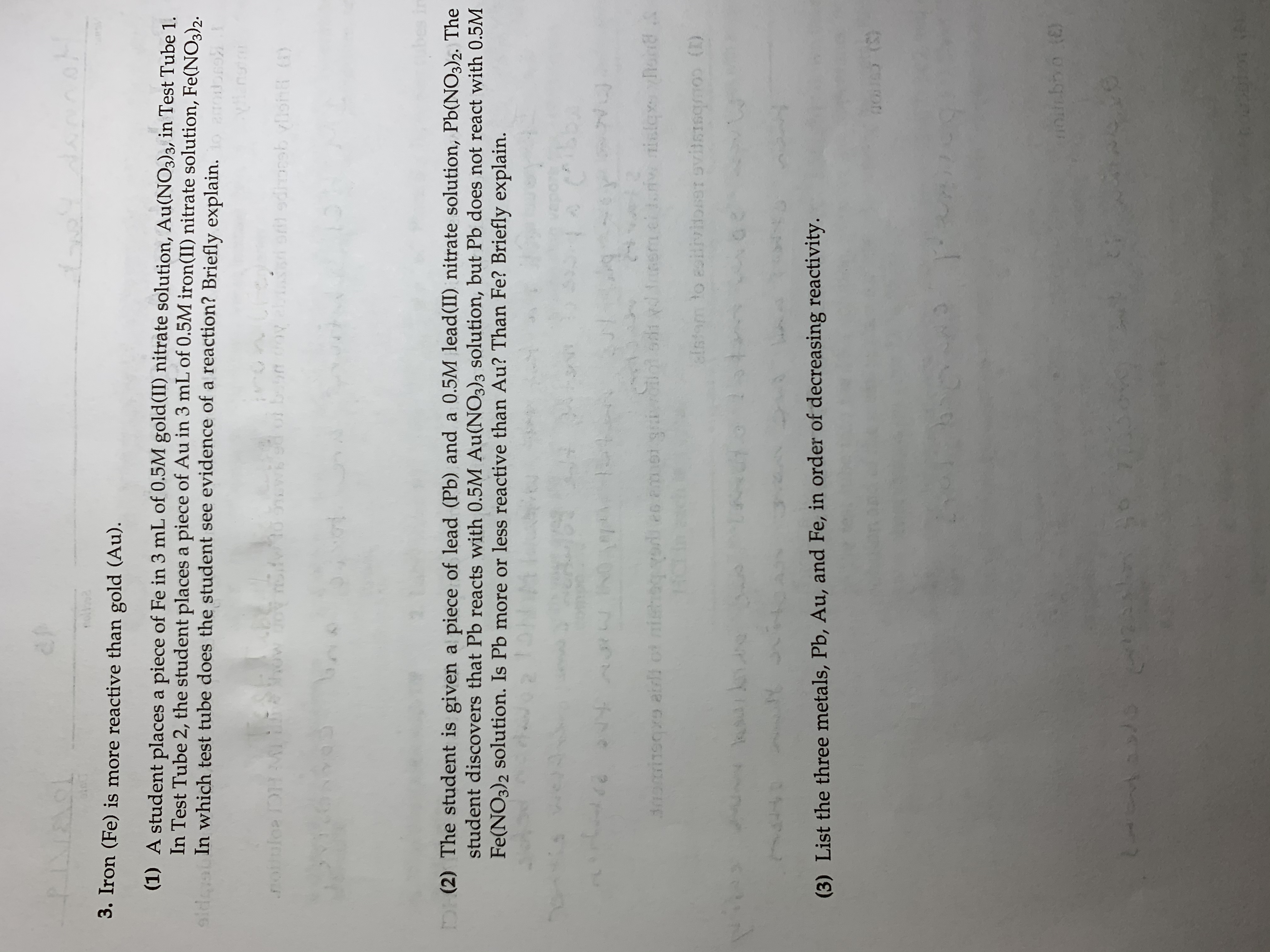
Chemistry
10th Edition
ISBN: 9781305957404
Author: Steven S. Zumdahl, Susan A. Zumdahl, Donald J. DeCoste
Publisher: Cengage Learning
expand_more
expand_more
format_list_bulleted
Question
How do I answer these questions? How do I figure them out?

Transcribed Image Text:ef
पा
L
3. Iron (Fe) is more reactive than gold (Au).
(1) A student places a piece of Fe in 3 mL of 0.5M gold(II) nitrate solution, Au(NO3)3, in Test Tube 1.
In Test Tube 2, the student places a piece of Au in 3 mL of 0.5M iron(II) nitrate solution, Fe(NO3)2.
oldca In which test tube does the student see evidence of a reaction? Briefly explain. dore
nun
.nollulo IDAMI L FA
ow
b
9diorsb vlh
ECLe p
bes in
DH(2) The student is given a piece of lead (Pb) and a 0.5M lead(II) nitrate solution, Pb(NO3)2. The
student discovers that Pb reacts with 0.5M Au(NO3)3 solution, but Pb does not react with 0.5M
Fe(NO3)2 solution. Is Pb more or less reactive than Au? Than Fe? Briefly explain.
164
s
4U!
24
sdi gd i
i ot mi
od es amei gr
110
30pisqvo airl
dstom Yo eoitivibsitsmscoo (0)
sa1evitsisqmos ()
uuyn
k
(3) List the three metals, Pb, Au, and Fe, in order of decreasing reactivity.
(S)
(JO
LAE 2/B
KAL
Expert Solution
This question has been solved!
Explore an expertly crafted, step-by-step solution for a thorough understanding of key concepts.
This is a popular solution
Trending nowThis is a popular solution!
Step by stepSolved in 6 steps with 6 images

Knowledge Booster
Learn more about
Need a deep-dive on the concept behind this application? Look no further. Learn more about this topic, chemistry and related others by exploring similar questions and additional content below.Similar questions
- 1. What are fibers and where are they found? How could forensic scientists use fibers to solve a crime? 2. Define the word probative. What is the probative value of a fiber in a forensic investigation? 3. Describe steps you would take from collecting a fiber(s) at a crime scene to performing an analysis to determine its identity. 4. Which of the 6 fiber types you observed are natural? Which are man-made? 5. Are fibers classified or individualized? Why?arrow_forwardUse the figure below to answer this question. Reflected Reflected by Reflected from earth's surface (4%) by clouds (20%) atmosphere (6%) V Absorbed by atmosphere (16%) Absorbed by clouds (3%) Absorbed by water, carried to clouds (23%) Absorbed by earth's surface (51%) What happens to incoming solar radiation? Radiated to space from clouds and atmosphere (64%) Radiation absorbed by atmosphere (15%) Convection (7%) Radiated to space from earth (6%) Most of it (>50%) is scattered by the atmosphere. Most of it (>50%) is reflected by the clouds. Most of it (>50%) is reflected from earth's surface. Most of it is absorbed by the earth and clouds in the lower atmosphere.arrow_forwardThe main issues with coral reefs in great barrier Australia.arrow_forward
- What is green chemistry? Choose the BEST answer. O Chemistry that uses only recycled chemicals. O Chemistry that makes something green in color. O Chemistry that comes from plants or uses plant materials. O Chemistry that uses non-toxic, non-harmful chemicals.arrow_forwardThe use of living organisms to help clean up areas of pollution is known as biodegradation. O bioremediation. O bioaccumulation. O bioreaction.arrow_forwardWhat chemicals do you think are most harmful to your own health? How are you exposed? How could you go about determining whether or not each of these chemicals was harmful to you?arrow_forward
arrow_back_ios
arrow_forward_ios
Recommended textbooks for you
 ChemistryChemistryISBN:9781305957404Author:Steven S. Zumdahl, Susan A. Zumdahl, Donald J. DeCostePublisher:Cengage Learning
ChemistryChemistryISBN:9781305957404Author:Steven S. Zumdahl, Susan A. Zumdahl, Donald J. DeCostePublisher:Cengage Learning ChemistryChemistryISBN:9781259911156Author:Raymond Chang Dr., Jason Overby ProfessorPublisher:McGraw-Hill Education
ChemistryChemistryISBN:9781259911156Author:Raymond Chang Dr., Jason Overby ProfessorPublisher:McGraw-Hill Education Principles of Instrumental AnalysisChemistryISBN:9781305577213Author:Douglas A. Skoog, F. James Holler, Stanley R. CrouchPublisher:Cengage Learning
Principles of Instrumental AnalysisChemistryISBN:9781305577213Author:Douglas A. Skoog, F. James Holler, Stanley R. CrouchPublisher:Cengage Learning Organic ChemistryChemistryISBN:9780078021558Author:Janice Gorzynski Smith Dr.Publisher:McGraw-Hill Education
Organic ChemistryChemistryISBN:9780078021558Author:Janice Gorzynski Smith Dr.Publisher:McGraw-Hill Education Chemistry: Principles and ReactionsChemistryISBN:9781305079373Author:William L. Masterton, Cecile N. HurleyPublisher:Cengage Learning
Chemistry: Principles and ReactionsChemistryISBN:9781305079373Author:William L. Masterton, Cecile N. HurleyPublisher:Cengage Learning Elementary Principles of Chemical Processes, Bind...ChemistryISBN:9781118431221Author:Richard M. Felder, Ronald W. Rousseau, Lisa G. BullardPublisher:WILEY
Elementary Principles of Chemical Processes, Bind...ChemistryISBN:9781118431221Author:Richard M. Felder, Ronald W. Rousseau, Lisa G. BullardPublisher:WILEY

Chemistry
Chemistry
ISBN:9781305957404
Author:Steven S. Zumdahl, Susan A. Zumdahl, Donald J. DeCoste
Publisher:Cengage Learning

Chemistry
Chemistry
ISBN:9781259911156
Author:Raymond Chang Dr., Jason Overby Professor
Publisher:McGraw-Hill Education

Principles of Instrumental Analysis
Chemistry
ISBN:9781305577213
Author:Douglas A. Skoog, F. James Holler, Stanley R. Crouch
Publisher:Cengage Learning

Organic Chemistry
Chemistry
ISBN:9780078021558
Author:Janice Gorzynski Smith Dr.
Publisher:McGraw-Hill Education

Chemistry: Principles and Reactions
Chemistry
ISBN:9781305079373
Author:William L. Masterton, Cecile N. Hurley
Publisher:Cengage Learning

Elementary Principles of Chemical Processes, Bind...
Chemistry
ISBN:9781118431221
Author:Richard M. Felder, Ronald W. Rousseau, Lisa G. Bullard
Publisher:WILEY